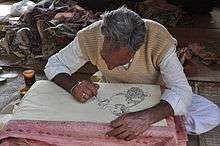Kalamkari
INTRODUCTION
Kalamkari or qalamkari is a type of hand-painted or block-printed cotton textile, produced in parts of India and Iran. Its name originates in the Persian ,قلمکار which is derived from the words qalam (pen) and kari (craftmanship), meaning drawing with a pen.
The Machilipatnam Kalamkari craft made at Pedana near by Machilipatnam in Krishna district, Andhra Pradesh, evolved with patronage of the Mughals and the Golconda sultanate.
There are two distinctive styles of kalamkari art in India - the Srikalahasti style and the Machilipatnam style. The Srikalahasti style of kalamkari, wherein the "kalam" or pen is used for free hand drawing of the subject and filling in the colors, is entirely hand worked. This style flowered around temples and their patronage and so had an almost religious identity - scrolls, temple hangings, chariot banners and the like, depicted deities and scenes taken from the Hindu epics - Ramayana, Mahabarata, Puranas and the mythological classics. This style owes its present status to Kamaladevi Chattopadhayay who popularized the art as the first Chairperson of the All India Handicrafts Board. Only natural dyes are used in kalamkari and it involves seventeen steps.

History

_-_overall.jpg)
In ancient times, groups of singers, musicians and painters, called chitrakattis, moved village to village to tell the village dwellers, the great stories of Hindu mythology. They illustrated their accounts using large bolts of canvas painted on the spot with simple means and dyes extracted from plants. In the same way, one found in the Hindu temples large panels of kalamkari depicting the episodes of Indian mythology, similar to the stained glasses of the Christian cathedrals.
As an art form it found its peak in the wealthy Golconda sultanate, Hyderabad, in the Middle Ages. The Mughals who patronized this craft in the Coromandel and Golconda province called the practitioners of this craft "qualamkars", from which the term "kalamkari" evolved.[1]
Kalamkari art has been practiced by many families in Andhra Pradesh and over the generations has constituted their livelihood. Kalamkari had a certain decline, then it was revived in India and abroad for its craftsmanship. Since the 18th century the British liked the decorative element for clothing.
Modern forms
In modern times the term is also used to refer, incorrectly, to the making of any cotton fabric patterned through the medium of vegetable dyes by free-hand painting and block-printing, produced in many different regions of India. In places where the fabric is block printed the kalam (pen) is used to draw finer details and for application of some colours.
Technique
The first step is to stiffen the cloth by seeping it in astringents and buffalo milk and then drying it under the sun.[2] Afterwards, the red, black, brown, and violet portions of the designs are outlined with a mordant and cloth is then placed in a bath of alizarin.[3] The next step is to cover the cloth, except for the parts to be dyed blue, in wax, and immerse the cloth in indigo dye. The wax is then scraped off and remaining areas are painted by hand,[4] similar to Indonesian batik.
To create design contours, artists use a bamboo or date palm stick pointed at one end with a bundle of fine hair attached to this pointed end to serve as the brush or pen.[5] This pen is soaked in a mixture of fermented jaggery and water; one by one these are applied, then the vegetable dyes.
In Iran, the fabric is printed using patterned wooden stamps.[6]
Color fixing
Dyes for the cloth are obtained by extracting colors from various roots, leaves, and mineral salts of iron, tin, copper, and alum.[7] Various effects are obtained by using cow dung, seeds, plants and crushed flowers to obtain natural dye. Along with buffalo milk, myrobalan is used in kalamkari. Myrobalan is also able to remove the odd smell of buffalo milk. The fixing agents available in the myrobolan can easily fix the dye or color of the textile while treating the fabric. Alum is used in making natural dyes and also while treating the fabric. Alum ensures the stability of the color in kalamkari fabric.
Themes
Kalamkari specifically depicts epics such as the Ramayana or Mahabharata. However, there are recent applications of the kalamkari technique to depict Buddha and Buddhist art forms.[8]
References
- ↑ Bhatnagar, Parul. "Kalamkari". Traditional Indian Costumes and Textiles. Retrieved 20 September 2011.
- ↑ metmuseum.org
- ↑ metmuseum.org
- ↑ metmuseum.org
- ↑ "Indian Heritage - Painting - Kalamkari". Retrieved 3 April 2016.
- ↑ Held, Colbert C. (2006). Middle East patterns: places, peoples, and politics. Boulder, Colo: Westview Press. ISBN 0-8133-4170-1.
- ↑ indian-heritage.org
- ↑ Naidu, T. Appala. "Techie's Twist to Kalamkari". The Hindu.
Further reading
- Kossak , Steven (1997). Indian court painting, 16th-19th century.. New York: The Metropolitan Museum of Art. ISBN 0870997831. (see index: p. 148-152)
- "A Short Note on Kalamkari". Retrieved 3 April 2016.
External links
| Wikimedia Commons has media related to Kalamkari. |
- Kalamkari by R.L. Shep
- Block Print Fabrics – Kalamkari Cotton
- Kalamkari - a Traditional Fabric of India